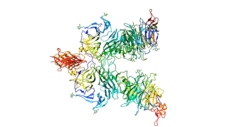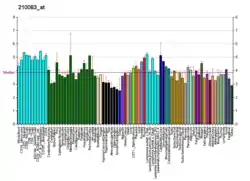SEMA7A
Semaphorin 7A, GPI membrane anchor (John Milton Hagen blood group) (SEMA7A) also known as CD108 (Cluster of Differentiation 108), is a human gene.[5]
SEMA7A is a membrane-bound semaphorin that associates with cell surfaces via a glycosylphosphatidylinositol (GPI) linkage. SEMA7A is also known as the John-Milton-Hagen (JMH) blood group antigen, an 80-kD glycoprotein expressed on activated lymphocytes and erythrocytes.[supplied by OMIM][5] SEMA7A is expressed in various adult tissues such as adipose, colon, esophagus, heart, brain, spleen, testis, lung, ovary, and uterus.[6]
Development
SEMA7A promotes axonal growth and is involved in mesoderm derived somite formation. Murine embryonic Sema7A expression is highest on day 7, which is indicative of its role on the differentiation of germ layer structure.[7] Embryonic Sema7A expression is noticeable at all developmental stages as well as in the newborn and adult thymus, indicative of a development T-cell role.[7] In wild type neurons, addition of Sema7A under in vitro conditions promotes elongation and branching in a dose dependent manner.[8] Unlike the majority of semaphorins, SEMA7A enhances axonal growth and is imperative for proper embryonic axonal tract formation.[9] Limited expression of SEMA7A is found in the hindbrain as opposed to an abundance of SEMA7A expression found in both the cranial and trunk neural crest cells, which indicates an involvement in migration and differentiation.[10] Sema7A -/- mice show defects in olfactory tract development.[11]
Tumorigenesis
In normal breast tissue, mRNA expression of SEMA7A is low or not expressed, but activation to re-express SEMA7A occurs in these adult tissues to cause pleiotropic effects which increase tumorigenesis.[12][13] Tumor cell growth, EMT, lung metastasis and angiogenesis have been linked to increased Sema7a expression in murine models.[14][15][16] Increased SEMA7A expression correlates with poor prognosis in breast cancer patients.[13] Tumors increase SEMA7A expression in an involuting environment, but knockout of SEMA7a in mouse models undergoing involution decreases lymphangiogenesis.[17]
Genetics
This protein is known to have eight variants in the extracellular region: seven lie within the Sema domain and one within the PSI domain.
Molecular biology
This protein forms dimers.
Notes
This protein acts as a receptor for the malaria parasite Plasmodium falciparum.
See also
References
- ENSG00000288455 GRCh38: Ensembl release 89: ENSG00000138623, ENSG00000288455 - Ensembl, May 2017
- GRCm38: Ensembl release 89: ENSMUSG00000038264 - Ensembl, May 2017
- "Human PubMed Reference:". National Center for Biotechnology Information, U.S. National Library of Medicine.
- "Mouse PubMed Reference:". National Center for Biotechnology Information, U.S. National Library of Medicine.
- "Entrez Gene: SEMA7A semaphorin 7A, GPI membrane anchor (John Milton Hagen blood group)".
- "Tissue expression of SEMA7A - Summary - The Human Protein Atlas". www.proteinatlas.org. Retrieved 2020-04-14.
- Mine, T.; Harada, K.; Matsumoto, T.; Yamana, H.; Shirouzu, K.; Itoh, K.; Yamada, A. (May 2000). "CDw108 expression during T-cell development". Tissue Antigens. 55 (5): 429–436. doi:10.1034/j.1399-0039.2000.550505.x. ISSN 0001-2815. PMID 10885563.
- Moresco, E. M. Y. (2005). "Integrin-mediated dendrite branch maintenance requires Abelson (Abl) family kinases". Journal of Neuroscience. 25 (26): 6105–6118. doi:10.1523/JNEUROSCI.1432-05.2005. PMC 6725048. PMID 15987940.
- Scott, Glynis A.; McClelland, Lindy A.; Fricke, Alex F. (January 2008). "Semaphorin 7a Promotes Spreading and Dendricity in Human Melanocytes through β1-Integrins". Journal of Investigative Dermatology. 128 (1): 151–161. doi:10.1038/sj.jid.5700974. PMID 17671519.
- Bao, Zheng-Zheng; Jin, Zhe (August 2006). "Sema3D and Sema7A have distinct expression patterns in chick embryonic development". Developmental Dynamics. 235 (8): 2282–2289. doi:10.1002/dvdy.20882. ISSN 1058-8388. PMC 1564195. PMID 16804892.
- Jeroen Pasterkamp, R.; Peschon, Jacques J.; Spriggs, Melanie K.; Kolodkin, Alex L. (July 2003). "Semaphorin 7A promotes axon outgrowth through integrins and MAPKs". Nature. 424 (6947): 398–405. Bibcode:2003Natur.424..398J. doi:10.1038/nature01790. ISSN 0028-0836. PMID 12879062. S2CID 12690989.
- Moserle, Lidia; Casanovas, Oriol (March 2012). "Exploiting pleiotropic activities of semaphorins as multi‐target therapies for cancer". EMBO Molecular Medicine. 4 (3): 168–170. doi:10.1002/emmm.201200206. ISSN 1757-4676. PMC 3376851. PMID 22323445.
- Black, S A; Nelson, A C; Gurule, N J; Futscher, B W; Lyons, T R (September 2016). "Semaphorin 7a exerts pleiotropic effects to promote breast tumor progression". Oncogene. 35 (39): 5170–5178. doi:10.1038/onc.2016.49. ISSN 0950-9232. PMC 5720143. PMID 27065336.
- Garcia-Areas, Ramon; Libreros, Stephania; Amat, Samantha; Keating, Patricia; Carrio, Roberto; Robinson, Phillip; Blieden, Clifford; Iragavarapu-Charyulu, Vijaya (2014). "Semaphorin7A promotes tumor growth and exerts a pro-angiogenic effect in macrophages of mammary tumor-bearing mice". Frontiers in Physiology. 5: 17. doi:10.3389/fphys.2014.00017. ISSN 1664-042X. PMC 3914020. PMID 24550834.
- Allegra, Maryline; Zaragkoulias, Andreas; Vorgia, Elena; Ioannou, Marina; Litos, Gabriele; Beug, Hartmut; Mavrothalassitis, George (October 2012). Chernoff, Jonathan (ed.). "Semaphorin-7a reverses the ERF-induced inhibition of EMT in Ras-dependent mouse mammary epithelial cells". Molecular Biology of the Cell. 23 (19): 3873–3881. doi:10.1091/mbc.e12-04-0276. ISSN 1059-1524. PMC 3459863. PMID 22875994.
- Ringnér, Markus; Fredlund, Erik; Häkkinen, Jari; Borg, Åke; Staaf, Johan (2011-03-21). Creighton, Chad (ed.). "GOBO: Gene Expression-Based Outcome for Breast Cancer Online". PLOS ONE. 6 (3): e17911. Bibcode:2011PLoSO...617911R. doi:10.1371/journal.pone.0017911. ISSN 1932-6203. PMC 3061871. PMID 21445301.
- Elder, Alan M; Tamburini, Beth AJ; Crump, Lyndsey S; Black, Sarah A; Wessells, Veronica M; Schedin, Pepper J; Borges, Virginia F.; Lyons, Traci R. (2018-09-25). "Semaphorin 7A promotes macrophage-mediated lymphatic remodeling during postpartum mammary gland involution and in breast cancer". Cancer Research. 78 (22): 6473–6485. doi:10.1158/0008-5472.CAN-18-1642. ISSN 0008-5472. PMC 6239927. PMID 30254150.
Further reading
- Xu X, Ng S, Wu ZL, et al. (1998). "Human semaphorin K1 is glycosylphosphatidylinositol-linked and defines a new subfamily of viral-related semaphorins". J. Biol. Chem. 273 (35): 22428–34. doi:10.1074/jbc.273.35.22428. PMID 9712866.
- Lange C, Liehr T, Goen M, et al. (1998). "New eukaryotic semaphorins with close homology to semaphorins of DNA viruses". Genomics. 51 (3): 340–50. doi:10.1006/geno.1998.5256. PMID 9721204.
- Yamada A, Kubo K, Takeshita T, et al. (1999). "Molecular cloning of a glycosylphosphatidylinositol-anchored molecule CDw108". J. Immunol. 162 (7): 4094–100. doi:10.4049/jimmunol.162.7.4094. PMID 10201933.
- Angelisová P, Drbal K, Cerný J, et al. (1999). "Characterization of the human leukocyte GPI-anchored glycoprotein CDw108 and its relation to other similar molecules". Immunobiology. 200 (2): 234–45. doi:10.1016/s0171-2985(99)80073-4. PMID 10416131.
- Tamagnone L, Artigiani S, Chen H, et al. (1999). "Plexins are a large family of receptors for transmembrane, secreted, and GPI-anchored semaphorins in vertebrates". Cell. 99 (1): 71–80. doi:10.1016/S0092-8674(00)80063-X. PMID 10520995. S2CID 17386412.
- Mine T, Harada K, Matsumoto T, et al. (2000). "CDw108 expression during T-cell development". Tissue Antigens. 55 (5): 429–36. doi:10.1034/j.1399-0039.2000.550505.x. PMID 10885563.
- Holmes S, Downs AM, Fosberry A, et al. (2002). "Sema7A is a potent monocyte stimulator". Scand. J. Immunol. 56 (3): 270–5. doi:10.1046/j.1365-3083.2002.01129.x. PMID 12193228. S2CID 26634136.
- Strausberg RL, Feingold EA, Grouse LH, et al. (2003). "Generation and initial analysis of more than 15,000 full-length human and mouse cDNA sequences". Proc. Natl. Acad. Sci. U.S.A. 99 (26): 16899–903. Bibcode:2002PNAS...9916899M. doi:10.1073/pnas.242603899. PMC 139241. PMID 12477932.
- Ota T, Suzuki Y, Nishikawa T, et al. (2004). "Complete sequencing and characterization of 21,243 full-length human cDNAs". Nat. Genet. 36 (1): 40–5. doi:10.1038/ng1285. PMID 14702039.
- Gerhard DS, Wagner L, Feingold EA, et al. (2004). "The status, quality, and expansion of the NIH full-length cDNA project: the Mammalian Gene Collection (MGC)". Genome Res. 14 (10B): 2121–7. doi:10.1101/gr.2596504. PMC 528928. PMID 15489334.
- Maurin JC, Delorme G, Machuca-Gayet I, et al. (2005). "Odontoblast expression of semaphorin 7A during innervation of human dentin". Matrix Biol. 24 (3): 232–8. doi:10.1016/j.matbio.2005.03.005. PMID 15907379.
- Hu Y, Malone JP, Fagan AM, et al. (2006). "Comparative proteomic analysis of intra- and interindividual variation in human cerebrospinal fluid". Mol. Cell. Proteomics. 4 (12): 2000–9. doi:10.1074/mcp.M500207-MCP200. PMID 16199891.
- Koh JM, Oh B, Lee JY, et al. (2006). "Association study of semaphorin 7a (sema7a) polymorphisms with bone mineral density and fracture risk in postmenopausal Korean women". J. Hum. Genet. 51 (2): 112–7. doi:10.1007/s10038-005-0331-z. PMID 16372136.
External links
- SEMA7A+protein,+human at the U.S. National Library of Medicine Medical Subject Headings (MeSH)
- John Milton Hagen blood group system in the BGMUT blood group antigen gene mutation database
- PDBe-KB provides an overview of all the structure information available in the PDB for Human Semaphorin-7A
This article incorporates text from the United States National Library of Medicine, which is in the public domain.





